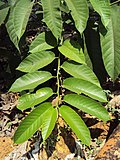Classification System: APG IV
Superregnum: Eukaryota
Regnum: Plantae
Cladus: Angiosperms
Cladus: Eudicots
Cladus: Core eudicots
Cladus: Rosids
Cladus: Eurosids I
Ordoo: Rosales
Familia: Moraceae
Tribus: Castilleae
Subtribus: Castillineae
Genus: Castilla
Species: C. elastica – C. ulei
Name
Castilla Cerv.
Castilla (sometimes incorrectly spelled Castilloa) is a genus of 3 species of large trees in the flowering plant family Moraceae. The genus is native to Central and South America.[1]
Etymology
This genus is named after Juan Diego del Castillo (d. 1793), a Spanish botanist who was a friend of Vicente Cervantes, who chose the name in his friend's honor.[2][3]
Description
Castilla species are monoecious or dioecious trees up to 40 meters tall, with buttressed trunks and abundant white latex of commercial value.[1] The branchlets have scars left by the fallen stipules. The leaves are oblong to elliptic, with entire margins.[1][4] The inflorescences are surrounded by bracts and have small flowers. The male flowers are borne in lengthwise-folded kidney-shaped inflorescences and female flowers in globose inflorescences.[1][4] The infrutescence varies in shape and has orange or red fruits.[1]
Ecology
The Panama rubber tree Castilla elastica, showing the scar where a branch has dropped. A recently fallen branch is posed at right
Castilla species exhibit a phenomenon known as cladoptosis, the regular shedding of branches. This may be an adaptation to prevent the growth of climbing plants.[5]
Castilla elastica is a weedy tree which has become invasive in areas where it has been introduced, such as in Tanzania and the South Pacific.[4][6]
Uses
The main species is Castilla elastica, one of several plants from which rubber has been extracted. The vernacular name is Panama rubber tree or castilloa rubber. The pre-Columbian MesoAmericans used the latex of this plant to make a ball used in a ceremonial game.
Species
| Image | Common Name | Scientific name | Distribution |
|---|---|---|---|
 |
Panama rubber tree, Castilloa rubber, palo de hule, olicuáhuitl | Castilla elastica Sessé | Mexico, Central America, and northern South America |
| Castilla tunu Hemsl. | Ecuador, Colombia, Panama, Belize | ||
| Caucho rubber, Caucho Negro | Castilla ulei Warb. | Brazil, Bolivia, Peru, Ecuador and Colombia |
See also
Rubber
References
Cardona–Peña, Victor; Fuentes, Alfredo; Cayola, Leslie (2005). "Las moráceas de la región de Madidi, Bolivia" (PDF). Ecología en Bolivia (in Spanish). Retrieved 23 May 2016.
González, J. "Explicación Etimológica de las Plantas de La Selva" (PDF). Flórula Digital de la Estación Biológica La Selva (in Spanish). Retrieved 23 May 2016.
Loadman, John (2005). Tears of the Tree: The Story of Rubber –a Modern Marvel. Oxford University Press. pp. 25. ISBN 9780198568407.
"Castilla elastica (PIER species info)". www.hear.org. Retrieved 2016-05-23.
Berg, C.C. (1977). "Castilleae, a tribe of the Moraceae, renamed and redefined due to the exclusion of the type genus Olmedia from the Olmedieae". Acta Botanica Neerlandica: 75. Retrieved 23 May 2016.
"Castilla elastica (Panama Rubber Tree)". BioNET-EAFRINET Keys and Fact Sheets. BioNET-EAFRINET. Retrieved 23 May 2016.
Retrieved from "http://en.wikipedia.org/"
All text is available under the terms of the GNU Free Documentation License

